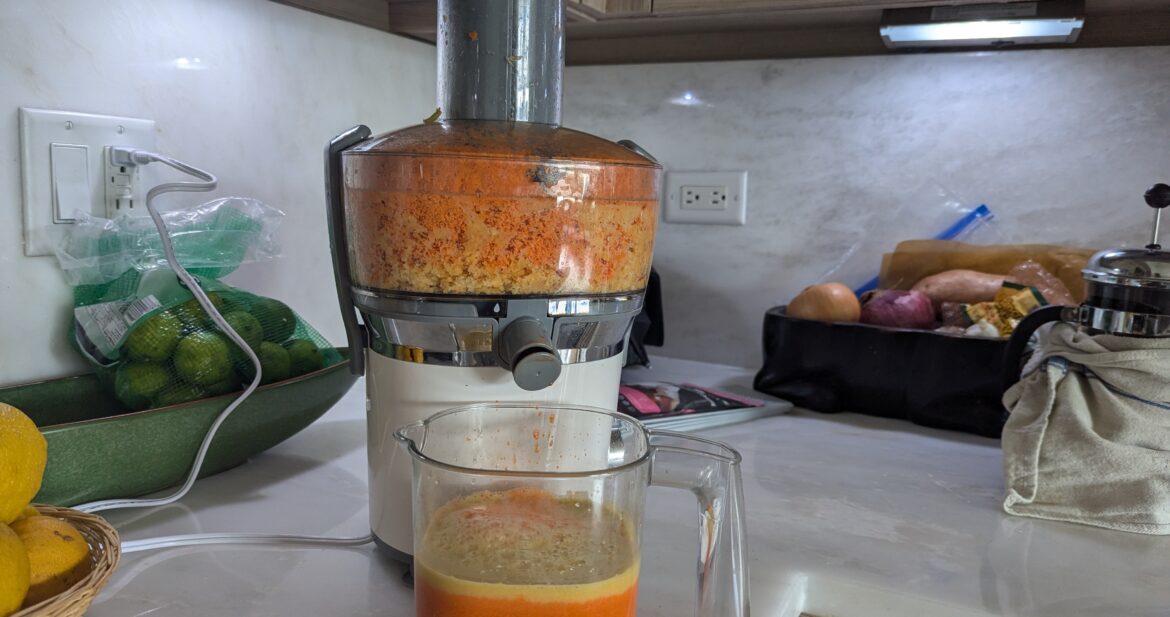Juicing is a simple way to boost your fruit and vegetable consumption, it’s gentle to digest and has reported benefits that range from improved immune function, gut microbime, blood sugar, bowel movements, mood, mental focus and skin clarity while also reducing inflammation.
New to juicing? Consider this your Juicing 101 basics to get you started!
Equipment:
A juicer: Juicing separates the liquid from the rest of the plant, delivering a concentrated source of micronutrients without fiber. A juicer will give you liquid (the juice) and pulp (all the remaining fiber). Pricing of juicers can range from $50 to $3,000. There are two basic types of juicers:
- Centrifugal juicer: uses spinning blades to slice the ingredients to small pieces. This creates more heat and can oxidize the juice quicker which can reduce nutritional content and affect flavor. This type of juicer may struggle with things like leafy greens. Still, there are some that work great, like this one from Breville.
- Masticating (or cold-press) juicer: crushes ingredients using an auger that turns at a much slower speed so it keeps heat and oxidation to a minimum and lessens foam and increases volume. Essentially these ‘squeeze’ rather than tear. Masticating slow juicer are more expensive (if you have $500+ to spend, I recommend the Nama), but you can find reasonable ones like this Shine.
You can use a blender and then strain the pulp out. This method is more cumberson but it doesn’t require purchasing a juicer.
The Ingredients
When it comes to juicing, nearly all fruits and vegetables are an option from fresh herbs to berries to leafy greens to carrots and ginger (note that some harder veggies, like beets, might challege a cheaper juicer.) Avoid juicing bananas, avocado, eggplan, mushrooms and rhuharb.
Keep the peel on for extra nutrients. Citrus peels will add quite a bit of bitter, those you may want to peel. Seed from citrus can stay but remove seeds from apples- tamygdalin, a chemical compound that includes cyanide and sugar. Crushing, or juicing, the seeds releases amygdalin, which produces a small amount of cyanide in the stomach and while that may be a very low amount, chronic/prolonged exposure can be a concern.
Frozen works too! Frozen fruits and veggies retain tons of nutrients and are an affordable option. Thaw the frozen produce before adding to the juicer.
Organic is great if it fits in your budget. Conventional produce is still a better option over processed food.
Pro’s and Con’s of Juicing
Juicing is a great way to boost nutition and give your digestion system a much needed break. Where juicing goes awry is using too many fruits (which can also be problematic with smoothies) and because the insoluable fiber, the fiber that adds bulk to stool, is removed you loose that ability to slow down how fast the sugar enters our blood stream.
Juicing retains soluable fiber, which is more easily accessed and broken down in the intestines into usable metabolites and can regulate the gut microbiota by producing beneficial short chain fatty acids. It also aids in lowering cholesterol.
Juice is great for when you aren’t as hungy or you want a quick source of energy and a boost of micronutrients.
Juicing 101 TiPS
-> Aim for 80/20 = 80% vegetables and 20% fruit. A straight green juice might not be as palatable as a fruit one in the beginning; slowly add more veggies and less fruit, palates do change!
-> Add soaked chia seeds and hemp seeds to juices for extra fiber and protein.
-> Pair juice with a protein or fiber-rich snacks.
-> Citrus will help the juice stay fresh, but it’s best to enjoy immediately. If storing beyond 48 hours it’s best to freeze.
-> Try freezing juice into popsicles for a healthy summer treat!
-> Compost the pulp or add it to soups, cakes, crackers, dog biscuits, broth and smoothies. Try my GF Carrot Pulp Carrot Cake!
Juice it up, snap a photo and tag @happyeatshealthy on IG!
Happy Juicing!
~Monique
Inflammation-fighting Ginger Carrot Juice
600 g carrots (roughly 3.5 cups)
1 apple, seeds removed
200 g, or 2, oranges peeled
1/2 lemon, peeled
1 thumb-size of fresh ginger
1 small fresh turmeric or 1/8 tsp ground
pinch of black pepper
Optional: 2-4 leafy greens, like kale
Place all the ingredients, except for black peper and ground turmeric, in the hopper and push through to juice. Stir in the black pepper and ground turmeric. Save the pulp and bake my GF Carrot Pulp Carrot Cake.
Enjoy your inflammation fighting Ginger Carrot Juice!

